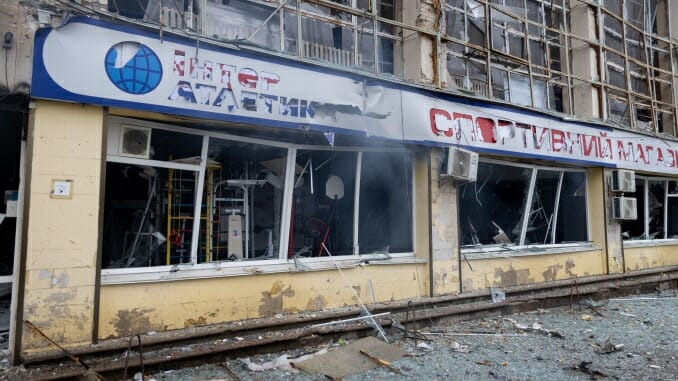It’s been decades since the world has seen an invasion like the one Russia is mounting against Ukraine, and though some aspects of war remain largely unchanged across the years — tanks on the ground, bombings through the air, troops at the border — Russia’s attack has also booted up a new front in warfare.
This war is raging in the streets, but also on social media platforms, in malware being manufactured and shot across government servers, and in board rooms where tech giants are trying to navigate how the fallout of economic sanctions need to be interpreted as Russian agents aim to use technology as a means to hamstring Ukraine and destabilize the nation’s digital infrastructure.
Even before the invasion began, teams of internet archivists started ramping up efforts to save and protect Ukrainian internet content. As Input reports, the effort was led by ArchiveTeam Warrior, which is a shared computing and processing application that allows hundreds of users to use extra processing power to archive content. More than 250 users reportedly helped share the load to archive terabytes of data that comprises the Ukrainian internet.
The goal of the project is to provide a living archive of the Ukrainian internet, in the event it is taken down or destroyed, blocked or corrupted as part of the Russian invasion.
“Hats off to them – it sounds like a tremendous undertaking,” Welton Chang, founder of social media intelligence firm Pyrra Tech and former chief technology officer at Washington, D.C. think tank Human Rights First, told Input. “Cyberwar and cybersecurity people have been talking about this for some time — at least since the mid-’90s — [saying] that as reliance on internet infrastructure increased, the more likely these assets would be first targeted in an actual interstate war.”
William Kilbride, executive director of the Digital Preservation Coalition, noted the modern internet has become as much — or more — of a cultural haven and lifeblood as the libraries of the past, which makes them a prime target for attack in a modern-day war like the one Russia is waging against Ukraine.
“War has always been a threat to culture and knowledge as well as to the libraries and archives that preserve it,” he told Input. “Ask the National Library of Bosnia, burned to ashes by the Serbian militia in 1992. The digital age is no different.” Kilbride adds that advances in technology in the last 30 years have been both a blessing and a curse: “The attack surfaces have expanded, but so have the evacuation routes.”
Those preservation efforts proved wise as the invasion began, as The New York Times reports a “never-before-seen piece of wiper malware” started setting off alarms within Microsoft’s malware monitoring stations, with the mysterious new virus aimed squarely at Ukraine’s key financial institutions and government agencies. Microsoft’s response was incredibly nimble, as the company’s threat center dissected the malware — now nicknamed “FoxBlade” — and within three hours had updated its virus detection to identify and block the malicious code before it could wipe data and wreak havoc on Ukraine’s digital infrastructure.
[W]e remain especially concerned about recent cyberattacks on Ukrainian civilian digital targets, including the financial sector, agriculture sector, emergency response services, humanitarian aid efforts and energy sector organizations and enterprises,” Microsoft President & Vice Chair Brad Smith said in a statement. “These attacks on civilian targets raise serious concerns under the Geneva Convention, and we have shared information with the Ukrainian government about each of them.”
Though Microsoft’s jump into the fray was a direct response to dangerous malware targeting infrastructure, other tech giants are still navigating the grey area of how to respond to Russia’s IRL aggressions on their digital platforms. Ukraine officials are pleading with tech juggernauts to restrict and cut-off Russia’s access to their services, and tech players Meta (aka Facebook), Google and Twitter have taken varied measures in recent days. Twitter began labeling tweets from Russian state media, while Meta and Google have stopped allowing Russia’s state-run media from buying ads on their platforms.
“These companies want all the benefits of monopolizing the world’s communications with none of the responsibility of getting swept up in geopolitics and having to choose sides,” Yael Eisenstat, a fellow at the Berggruen Institute, a Los Angeles think tank, who formerly led Facebook’s election integrity operations, told The New York Times about the challenges these companies face while trying to make these decisions in real-time.
In one interesting twist, Elon Musk himself has stepped in to provide access to his Starlink satellite internet service in an effort to try and help Ukrainians keep their internet access up and running during the siege, after a Ukrainian official put out a plea directly to the SpaceX founder on Twitter. The service is made up of thousands of low-Earth orbit satellites beaming high-speed internet to more remote areas, and Musk provided at least a handful of terminals to Ukraine to keep the connection flowing.
As we see footage of deadly bombings scroll across our Twitter feeds and read new harrowing — and heroic — accounts of events on the ground with each passing day, it’s clearer than ever how technology is changing the way war is perceived and reported globally. In many cases, we’re able to follow along in real-time as events unfold.
Modern technological advancements and the defensive measures aimed at protecting them make all that possible, which provides a hard reminder for why Russia is fighting so hard to control it — and why Ukraine is fighting so hard to preserve it.
